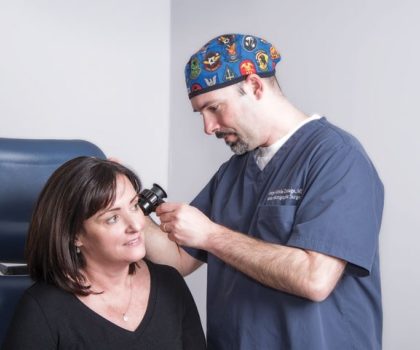I had skin cancer

By Laura Briedis
Laura Geller’s story sounds all too familiar. She grew up in a generation where folks were not as conscious about using sunscreen when spending time outdoors or at the beach. Now, years of sun exposure has resulted in skin cancer.
“The damage was done back in my high school and college years,” says the 50-year-old who lives in the Greater Cleveland area. “I was a lifeguard for many summers at the city pool and back then we used sunscreen with a lower Sun Protection Factor (SPF).”
Luckily, early detection makes skin cancers highly treatable. During a regular checkup a couple of years ago, Dr. Jorge Garcia-Zuazaga, founder of Apex Dermatology, found a suspicious spot on the top of her foot.
“I thought it was just a scratch because it was right where the bands of my flip flops would rub,” says Laura. “It turned out to be basal cell carcinoma.”
Since then, Laura has had two more lesions, by the crux of her eye and on her neck, which Dr. Garcia successfully treated with Mohs micrographic surgery. An expert on Mohs surgery, Dr. Garcia did his fellowship at Harvard Medical School and has performed more than 15,000 surgeries.
“I have freckly skin, but Dr. Garcia is very diligent and thorough. He can always spot any concerns,” she says. “For me, they were shiny, clear and scaly, not the typical dark moles people usually associate with skin cancer.”
“I have become an ‘honorary’ dermatologist,” she laughs. “After having three bouts with skin cancer, I know what to look for. I even take photos on my cellphone of any suspicious looking spots to show my doctor when I come in because sometimes spots will go away but then come back.”
Her advice: Get screened in a doctor’s office and do self-exams at home.
“The key to combating skin cancer is accurate, timely diagnosis of any moles and skin lesions through frequent screenings,” concurs Dr. Garcia.
He tells his patients to watch for the “ABCDEs of melanoma” to detect potentially dangerous spots. Look for asymmetry, irregular borders with jagged or notched edges, spots with multiple colors, diameter that exceeds the size of a pencil eraser and any areas that are evolving—either by getting larger, bleeding, crusting, itching, shrinking or becoming bumpy.
“If you see a suspicious lesion, don’t wait. The longer you hold off the more advanced therapies you may need,” says Dr. Garcia, noting Apex Dermatology’s SPOTcheck Program guarantees patients will be seen within 72 hours if they find a suspicious spot that is new, scaling or bleeding.
“Even though I have had skin cancer, I still love going to the beach and spending time outdoors,” says Laura. “But now I am diligent about wearing sunscreen and protective clothing to reduce sun exposure.”
Apex Dermatology has five locations to serve the Greater Cleveland/Akron areas. Visit ApexSkin.com for more information. Flexible weekday hours are available. Saturday appointments are available at some locations.
